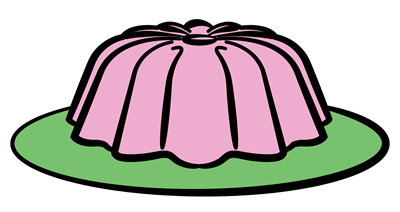 Hello everyone! Welcome to this week’s mid-century menu. This week I tried a recipe from one of my new cookbooks that I recently bought at the Midland Antiques Festival. I was lucky enough to find a whole pile of these little cookbooks for pretty cheap at one booth, and you can be sure that I snapped up everything I could!
Hello everyone! Welcome to this week’s mid-century menu. This week I tried a recipe from one of my new cookbooks that I recently bought at the Midland Antiques Festival. I was lucky enough to find a whole pile of these little cookbooks for pretty cheap at one booth, and you can be sure that I snapped up everything I could!
The victim this week (besides Hubs) is from this cute little book, “None Such” Mince Meat Recipes for Winter, Spring, Summer and Fall, published in 1952* (Thanks, Sablemable!). Now, I thought that mince meat was only used for questionable pies made at Christmas time. Apparently that isn’t so. The lovely people at None Such created a whole BOOK of recipes that you can serve year round, if you are brave enough. And only about half of them are pie.
The “crazy” thing about this book is that not only are there 21 recipes in this book, but also 21 ingredients in None Such Mince Meat! What an amazing coincidence.
Thankfully, there are no longer 21 ingredients in None Such Mince Meat. A look at the modern packaging shows only about 12 ingredients. Why am I thankful? Well, not sure exactly which ones are no longer used, but modern mince meat actually has no meat in it. Which is good, because the mid-century version had beef in it. Blech.
In any case, despite my fear of eating meat in my mince meat, I decided to make the one recipe in this book that actually ADDS meat to mince meat.
The None Such Ham Loaf.
 Since it is the only actual meal in the book, it was pretty much a shoe-in for the Mid-Century Menu. Unless they meant it to be a dessert. In which case, it is even more qualified.
Since it is the only actual meal in the book, it was pretty much a shoe-in for the Mid-Century Menu. Unless they meant it to be a dessert. In which case, it is even more qualified.
By the way, this whole cookbook is incredibly freaky. I choose to serve the only item that is considered to be dinner, but every “dessert” in the book contains beef from the mince meat. So, those oatmeal cookies = Beef Cookies. The None Such Cake = Beef Cake. You get the picture. And it isn’t a pretty one.

All the ingredients, assembled and waiting. Check out the condensed mince meat I found at the local grocery store. I didn’t think they still made it, but they do! It was about half the price of the jar version, so I bought it.

Here is the mince meat, reconstituting. According to the cookbook, I was supposed to notice the delicious aroma as it cooked. It just smelled like apples and raisins to me. But that isn’t a bad thing.

Ham, bread, onions and milk all together. It actually isn’t that bad at this point.
 Adding the mince meat. I was surprised that it actually smelled good. There was the delicious aroma I was promised! The only bad thing at this point was that the loaf could have used some binder, like an egg or something. It was so crumbly and really hard to work with.
Adding the mince meat. I was surprised that it actually smelled good. There was the delicious aroma I was promised! The only bad thing at this point was that the loaf could have used some binder, like an egg or something. It was so crumbly and really hard to work with.
 Here it is, packed into the pan and ready for the oven. At this point it still smelled pretty good, so I wasn’t really worried. I was actually looking forward to tasting it to see what the verdict would be.
Here it is, packed into the pan and ready for the oven. At this point it still smelled pretty good, so I wasn’t really worried. I was actually looking forward to tasting it to see what the verdict would be.
 Fresh from the oven and depanned. I didn’t have a can of peaches to sling over it, like in the cookbook, but I figured it didn’t matter in the long run.
Fresh from the oven and depanned. I didn’t have a can of peaches to sling over it, like in the cookbook, but I figured it didn’t matter in the long run.
So, Hubs and I sat down to eat. We cut slices, and stuck the first forkful in.
Yuck.
“This is…kind of nasty,” Hubs said. I was surprised to hear him voice it first. Usually I am the one who is screaming the roof off with disgust.
It was nasty. It was very, very sweet. I had left out the extra salt, thinking it would be salty enough with all the ground ham, but it could have used that salt. And probably a lot more besides that.
“Too bad this isn’t really meatloaf,” I joked, “then we could slather ketchup all over it.”
Hubs got an unholy look in his eye. “Let’s try it with ketchup,” he said, “it can’t be worse, right?”
So the ketchup came out and on the ham loaf. It was better, but only enough to make it edible. Only if you closed your eyes and pretended we were eating meatloaf.
The Verdict: Edible with Ketchup
And now the true irony: This meal was saved by ketchup while other mid-century meal experiments were ruined by it. Interesting, isn’t it?



Gag me with a spoon!!!!!! I had never heard of None Such Mince Meat before, but, since I don’t really like mince meat pie, I’ve never searched for such a creature on the supermarket shelves.
Out of curiosity, Ruth, what year was this booklet published?
Ugh!
Hi Sable!
It was pretty nasty – and I hate mince meat pie! The booklet was from 1952. Thanks for asking and reminding me to add it to the post!
Wow Ruth, I can’t imagine what it would have been like had you put the canned peaches on the top – GROSSLY sweet! Props to ketchup, for saving the meal. I think this is the first meal that Hubs had to add something to so he could finish? Maybe??? “Where are the bologna sacks?” – still laughing about that one!
That looks truly awful.. meat loaf is bad enough on it’s own, this is terrifying!
Cool recipe booklet – I dig those. I use mince alot here as it’s alot cheaper than most meat but I’m afraid nowadays we have much more interesting and appetising ways of cooking it.
This recipe may replace the Chinese egg one as the most awful!
LOL, you know, Ruth, we ALL can’t wait for Wednesdays to roll around!
You have a cult following!
Ha ha ha! Your write ups on these crack me up! I always expect you to say how wonderful they are! 🙂 And I can’t believe you found the original meat – you wonder who keeps that company in business don’t you?
Sorry for the WAY after the fact comment (much like many of your new readers, I found this website from a buzzfeed post, and have been fascinated ever since, as a fellow collector of mid-century cook books, though I’ll admit I’ve only ever made things that actually seemed like they would be good from them, mostly cakes and such), but I just had to clear up a misconception.
Mincemeat is a bit of a misnomer. Yes, the traditional recipes did indeed include beef products in it, but rather than chunks of ground burger like we usually picture, what it really included was shredded beef suet, which is the fat encasing the kidneys, and a staple of traditional English cooking. Yes, it does wind up giving a flavor to the finished product, but not so much that you’d actually think it was meat. Really all it does is act as fat in the recipe.
Though to append the comment more, I gather at one time, and we’re talking like 1700s here, there did exist a meat/fruit/spice concoction called “mincemeat pie” that seems to be more of a “oh god this meat is so damn gamey and rotten that we need to put something on it to make it somewhat edible” than a “mmm, this is culinary magic” sort of thing.
Anyways, great blog, I’m so happy to find other people who actually share my fascination with mid-century cooking (and aesthetic)!